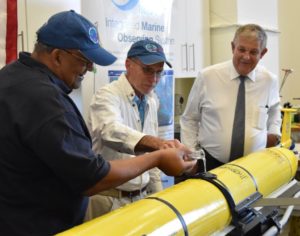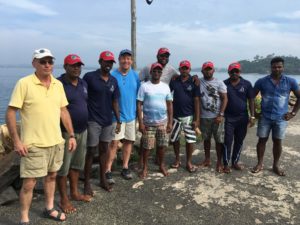-
International Challenger RU29 Mission Update
Posted on September 12th, 2019 No commentsRU29 is tuning up to measure currents: RU29 spent the day profiling in about 1000 m depths off Virgin Gorda, with operators tweaking settings on the onboard Doppler current velocity profiler to optimize its ability to measure ocean currents. An important aspect of the mission will be measuring speed and direction of currents below the surface to determine the movement of the water masses distinguished by their temperature and salinity characteristics.
Currents in the region can be strong and have complex patterns. The figure below shows the modeled (US Navy AMSEAS model) currents in the region for 11 September, 2019. RU29 is in an area of northward surface currents greater than 1 knot. Ocean gliders themselves are only capable of forward speeds of around 0.5 knots, and only when they are ascending or descending. In order to make headway, they depend on spending most of their time well below the surface, where the currents are generally slower. If necessary, the glider does have a small electric motor and propeller which it can use, but at the cost of tapping into its limited battery reserves.
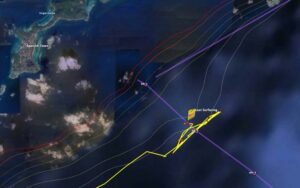
RU29 recent trackline and position on 11 September 2019. The glider should begin its trip across the Anegada Passage station line on 12 September.
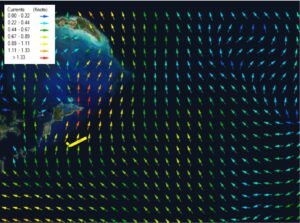
Modeled surface current vectors from the US Navy AMSEAS model from 2100 UTC, 11 September, 2019. From OCEANSMAP Caribbean.
To see all of the current reports, you can view them here: http://ocovi.azurewebsites.net/resource/Ru29
The International Challenger RU29 Mission is a collaboration among Rutgers University (New Brunswick, NJ) Center for Ocean Observing Leadership, Ocean and Coastal Observing – Virgin Islands (OCOVI, an affiliate of the US Integrated Ocean Observing System (IOOS) Caribbean Coastal and Ocean Observing System (CARICOOS)), and the University of the Virgin Islands. This mission will collect upper ocean data to improve hurricane forecasting models; study conditions in the Anegada Passage, an important region for NE Caribbean climate change; and build international cooperation for ocean observing and glider activities. The mission will work in the waters of the US Virgin Islands, British Virgin Islands, and Anguilla, under international Marine Science Research permit . Funding for the project comes from the U.S. National Oceanic and Atmosheric Adminstration through the IOOS, Rutgers University, and the G. Unger Vetlesen Foundation.
-
RU29 – 2 years ago
Posted on November 8th, 2018 No commentsChari just sent this photo from the Perth glider port looking back 2 years at the re-christening of RU29 with water from the Indian Ocean before the start of its historic mission within IIOE-2.
Looking back at all that was accomplished, I first think of all the people that made it possible. Working together, we advanced the technology, we explored an ocean with new threats, and we overcame new challenges on shore. We made new friends, and together, accomplished something that was hard. Some call these types of friends comrades, some call them mates. In Spanish, we call them companeros. Our co-workers, our partners, our equals. All dedicated to a common goal. Companeros have a bond that has been tested, and a bond that has survived, because of a shared vision that is bigger than our differences.
With the return of RU29, we now focus our attention on the next mission. I look forward to working with all of you as we prepare to redeploy from Spain in September of 2019. The preparations will be hard, and seeing the mission through to the end will be even harder.
But we are companeros.
Borrowing words from our global navigator – Force, wind and honor all.
-
Recovery Team Photos
Posted on November 2nd, 2018 No commentsRU29 recovery team arrives at the fishing port of Marissa. Flags are from NOAA, the Explorers Club and Rutgers. Captain and crew of the Marissa wearing red RUCOOL caps.
Entire group back onshore by the Marissa Fishing Marina.
-
RU29 Damage – First look
Posted on November 2nd, 2018 No commentsFirst approach. Usual barnacles. Rudder is still attached but is hard over.
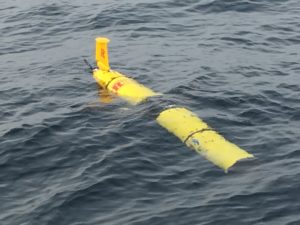
On board the Crystal. Deep scratches on the tail, port side.
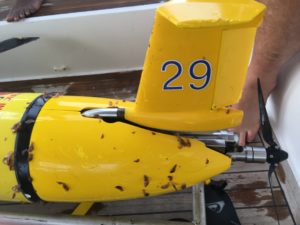
Deeper scratches on the starboard side.

Forward energy bay has numerous scratches.

Pitch battery hull scratched on the bottom.
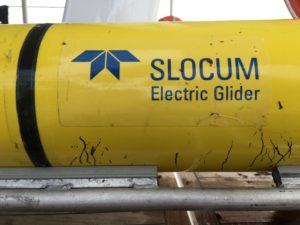
-
Hello from Marissa
Posted on November 1st, 2018 No commentsOscar and I are here in Marissa, same place we picked up RU29 after its record breaking mission flying from Perth, Australia.

RU29 is currently 8 nautical miles due south of Marissa Harbor. It is still in deep water to help with station keeping. The surface currents are strong, so we like to wait at depth.
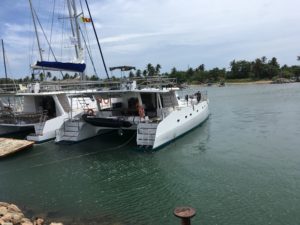
Our boat is the catamaran Crystal. We stopped by today to see the vessel and meet the captain and crew. We have two staircases down to the water level platform, one on each side. The captain and lookouts will be on the upper deck as we approach the glider.
Tomorrow’s schedule in Sri Lanka times:
Van pick up at hotel 4:30 am. At boat by 5 am. Boat loaded and set up for 5:30 am – 6:00 am departure. On site by about 7 am our time. We’ll get the current location of RU29, and a waypoint to head to that is just to the east of the current location. We head to our waypoint and then turn west, approaching the glider with the sun at our back. We will be standing on the upper deck looking for the glider with the Iridium phone getting text updates of location and the gps to let us know which way to go.
-
Safe Travels
Posted on October 31st, 2018 No commentsGlider team has arrived in Mirissa Sri Lanka! Glider is approximately 17 km off shore in 1000m water. There is a scheduled boat trip to recover glider Friday at 6am (Sri Lanka time) at Welligama Bay.
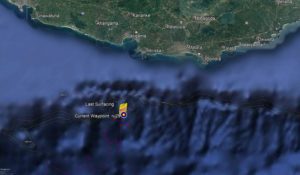
Attached are glider packing test fits for RU29 when it is home bound.
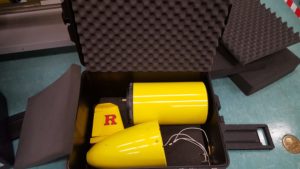
energy bay hull+tail
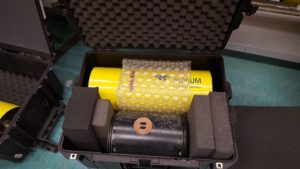
science bay+aft hull
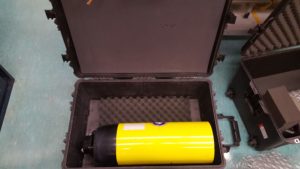
front end
-
70 kilometers to pick up point
Posted on October 20th, 2018 No commentsWe did some tests flight tests on Friday, and are now back to heading towards the pick up point. The latest measured heading plot shows RU29 is now flying about 60 degrees to the right of the commanded heading.
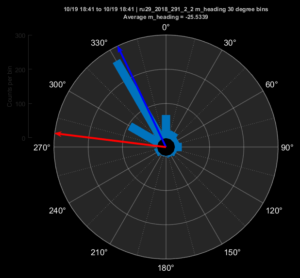
Below image is zoomed into the local area with the new Copernicus model currents. The direction we want to head is to the NE, at a heading of about 30 degrees. With the 60 degree offset noted above, we can give RU29 a waypoint that is to the NW at a heading of 330 degrees. That new waypoint is shown in the cyan color.
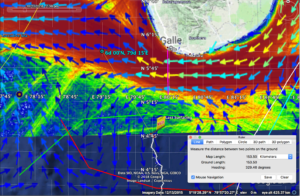
The Copernicus currents show that there is a strong current to the west just south of Sri Lanka in the region with the high vessel traffic. That means there are two hazards if we move into that area, vessels that can hit us and currents that can sweep us away.
Below is the important model comparison. You always hope the models agree so that you have more confidence in the currents.
First is Copernicus, the European model. There is a strong alongshore current to the west offshore suthern Sri Lanka that covers the shipping lanes in red. RU29 is in a relatively low current zone, near the middle to western side of a counterclockwise eddy. Currents at RU29 are weak ant to the south.
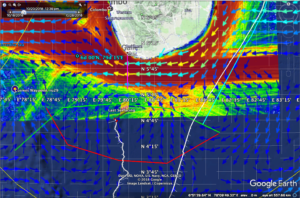
Now for the two US models. First the Navy HYCOM. Here RU29 is on the eastern side of a very strong and elongated clockwise eddy. The elongation is in the direction of altimeter tracks – wish I could overlay them somehow. The strong eddy is disrupting the alongshore flow by southwestern Sri Lanka and turning it to the east. Currents at RU29 are strong and to the southeast.
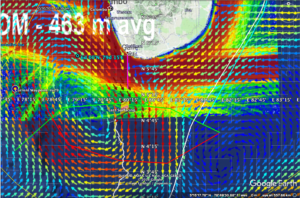
Last is NOAA RTOFs. Same story as Hycom, bit now the eddy is round, not elongated like an altimeter track.
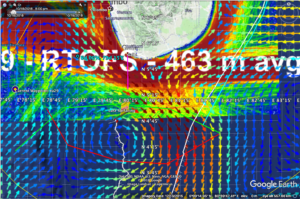
-
Position prior to flight tests
Posted on October 19th, 2018 No commentsMeasured heading rose has RU29 flying about 115 degrees to the right of the commanded heading
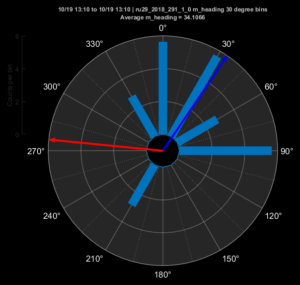
We made the waypoint change to give a commanded heading near 300 degrees. This turned the glider to fly more like an ENE direction, directly at our proposed pick up point. We are 70 km away from that point that is 40 nautical miles south of Galle, Sri Lanka and is right on the souther edge of the shipping lanes. We have been making about 15 km of progress per day.

We will be doing some flight tests for the remainder of this day (friday) in preparation for the station keeping we will need to do at the pick up point.
-
Third Test – same answer
Posted on October 13th, 2018 No commentsWaypoint to west, with commanded heading in red towards 270 degrees. Average heading towards 30 degrees, or 120 degrees to the right of the commanded heading.
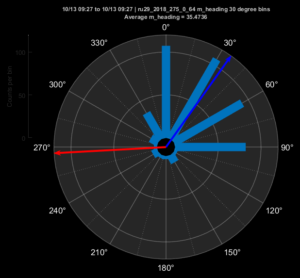
Glider moved in the direction of the averaging heading, towards the northeast. So no currents for third try, Copernicus (the currents shown here) is a clear winner.
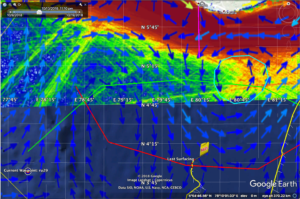
We are 150 km from our intended pick up point just south of the shipping lanes. We are averaging 15 km/day. So 10 days from today, Oct 13, is Tuesday, Oct 23. Gives us a several day window for unexpected currents beyond that.
-
Second test – time to shift waypoint north
Posted on October 13th, 2018 No commentsThe heading rose plot from the last segment has an average heading 75 degrees to the right of the commanded heading. So we do not have an steady offset or trend. Sometimes the offset is less than 90 degrees to the right. Sometimes more. But it tends to oscillate around 90 degrees to the right of the commanded heading.
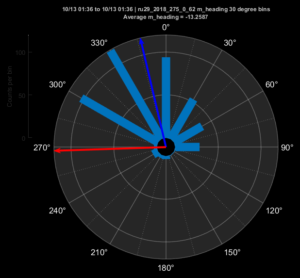
During this segment the glider moved to the northwest, in the direction of the average heading. So the currents are low. More evidence copernicus model is right. Copernicus currents are shown here.
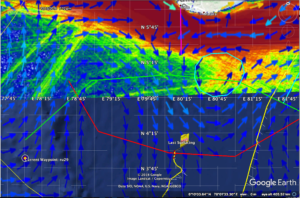
So our plan is to continue sliding the waypoint north a little bit each day and walk this glider up to the edge of the shipping lanes, about 40 nautical miles south of Galle.
Current waypoint is just south of 4 N. We can shift it 10′ north to about 4 degrees, 10′ north before the next surfacing in early afternoon.



